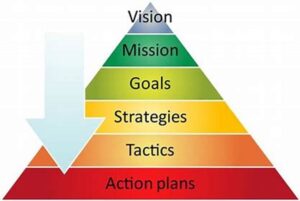 The Strategic Plans at its root is the concept of taking concepts and turning them into action. This is what the best organizations do and are at the heart of literally every business management book ever written. To get from “Good to Great” you will need to establish your goals and priorities which are then translated into action.
The Strategic Plans at its root is the concept of taking concepts and turning them into action. This is what the best organizations do and are at the heart of literally every business management book ever written. To get from “Good to Great” you will need to establish your goals and priorities which are then translated into action.
Getting your plan into shape is not difficult. It really only requires the ability to sit down with your City Council, key staff and get started.
A strategic plan is a comprehensive document that outlines an organization’s goals, objectives, and strategies for achieving them.
The key elements of a strategic plan are:
- Vision statement: A statement that outlines the organization’s long-term aspirations and what it hopes to achieve in the future.
- Mission statement: A statement that defines the organization’s purpose and how it will achieve its vision.
- SWOT analysis: An analysis of the organization’s strengths, weaknesses, opportunities, and threats.
- Core values: A set of guiding principles that define the organization’s culture and how it operates.
- Goals: Specific, measurable, achievable, relevant, and time-bound objectives that the organization aims to achieve.
- Objectives: Specific, measurable, achievable, relevant, and time-bound steps that the organization will take to achieve its goals.
- Action plans: Detailed plans that outline the specific actions that the organization will take to achieve its objectives.
These elements are not mutually exclusive and can and in most cases become interdependent.
For cities, these key elements of the plan will flow into:
- City Budget- The elements of the strategic plan are highlighted throughout the entire document within the departmental narratives and key goals and objectives listed for each. Ultimately, the priorities are funded and linked back to the plan.
- Capital Planning– where the strategic nature for the construction and improvement of key assets is highlighted in relation to the larger goals and vision for the community. The latter aspects of the vision for the city will be highlighted in the scaling of capital facilities into multiple phases to realize the incremental attainment of key goals and capacities.
- Financial Planning– whereby the City establishes policies and programs which will build toward the funding of both current and future outcomes. These often are translated into the funding of reserves and major projects financing programs. The city will also
The strategic plan is a living document which is embedded in active documents and programs which are regularly reviewed and updated. These documents help identify the incremental progression of plan implementation and success along with the identification of next steps.
Here is a relatively recent example of a strategic plan which I developed for the City of Auburn.
